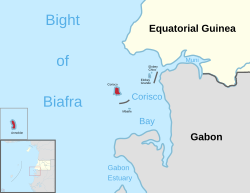Elobey, Annobón, and Corisco facts for kids
Quick facts for kids
Elobey, Annobón, and Corisco
Elobey, Annobón y Corisco (Spanish)
|
|||||||||
|---|---|---|---|---|---|---|---|---|---|
| 1843–1926 | |||||||||

Spanish protectorate and colony
of Elobey, Annobón, and Corisco |
|||||||||
| Status | Dependency of Spanish Guinea |
||||||||
| Capital | Santa Isabel | ||||||||
| Common languages | Spanish | ||||||||
| Monarch | |||||||||
|
• 1844–1868
|
Isabella II (1st) | ||||||||
| History | |||||||||
|
• Established
|
1843 | ||||||||
|
• Disestablished
|
1926 | ||||||||
| Area | |||||||||
|
• Total
|
36 km2 (14 sq mi) | ||||||||
| Currency | Spanish peseta | ||||||||
|
|||||||||
| Today part of | Equatorial Guinea | ||||||||
Elobey, Annobón, and Corisco was a group of islands in Africa that were once ruled by Spain. These islands included Annobón, which is in the Gulf of Guinea near São Tomé and Príncipe. It also included the smaller islands of Elobey Grande, Elobey Chico, and Corisco. These smaller islands are located in the Corisco Bay, close to the Mitémélé River.
Spain started ruling these islands as a "protectorate" in 1843. This meant Spain protected and controlled them. The total area of these islands was quite small, less than 36 square kilometers (about 14 square miles). In 1910, about 2,950 people lived there.
The islands were managed by a governor-general based in Santa Isabel. This governor had assistants called lieutenant governors on Annobón and Elobey Chico.
In 1926, all of Spain's lands in the Guinea area were joined together. They formed a larger colony called Spanish Guinea. This colony later became the independent country of Equatorial Guinea in 1968. Today, Elobey Grande, Elobey Chico, and Corisco are part of the Litoral Province in mainland Equatorial Guinea. Annobón is its own province within the Insular Region.
History of the Islands
The island of Annobón was found by Portuguese explorers on January 1, 1472. This is why it was named Ano Bom, which means "Good Year" in Portuguese. It was named after New Year's Day.
Spain began to control these islands in 1777. Annobón was given to Spain along with Fernando Po in 1778. This happened as part of a deal called the 1778 Treaty of El Pardo. In exchange, Spain gave Portugal some land in South America.
Later, in 1959, Annobón was joined with the island and province of Fernando Poo. Elobey and Corisco became part of the Spanish mainland area called Río Muni. All these areas then formed Spanish Guinea.
Stamps from the Islands
These islands are famous among stamp collectors because they printed their own postage stamps. They issued stamps between 1903 and 1910.
The very first stamps, from 1903, showed a picture of the young King Alfonso XIII of Spain. There were 18 different stamps, with values from ¼ centimos to 10 pesetas.
In 1905, some of these stamps were printed again, but they still had the 1903 date. In 1906, new values were made by stamping over the old stamps. The 1907 series had 16 different stamps, from 1c to 10 ptas. These stamps showed an older King Alfonso. Some of these stamps had new values printed on them between 1908 and 1910.
In total, 72 different stamp issues from these islands are known. After 1910, the islands started using stamps from Spanish Guinea.
See also
 In Spanish: Elobey, Annobón y Corisco para niños
In Spanish: Elobey, Annobón y Corisco para niños




